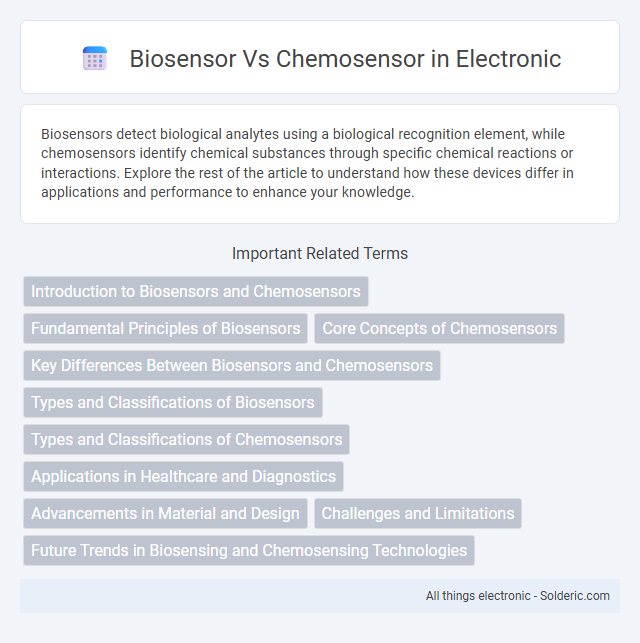Biosensors detect biological analytes using a biological recognition element, while chemosensors identify chemical substances through specific chemical reactions or interactions. Explore the rest of the article to understand how these devices differ in applications and performance to enhance your knowledge.
Comparison Table
| Feature | Biosensor | Chemosensor |
|---|---|---|
| Definition | Device that detects biological molecules using a biological recognition element | Device that detects chemical substances using chemical reaction or physical change |
| Recognition Element | Biological components (enzymes, antibodies, nucleic acids) | Chemical receptors, catalysts, or synthetic materials |
| Analyte | Biomolecules (glucose, DNA, proteins) | Chemicals (gases, ions, toxins) |
| Sensitivity | High sensitivity and specificity | Moderate sensitivity, depends on chemical interactions |
| Applications | Medical diagnostics, environmental monitoring, food safety | Industrial process control, environmental sensing, hazard detection |
| Response Time | Generally fast, depends on biological interactions | Rapid, often instantaneous chemical response |
| Stability | Lower stability, sensitive to environmental changes | Higher stability, robust to environmental conditions |
| Reusability | Often limited due to biological element degradation | Higher reusability with proper regeneration |
| Cost | Generally higher due to biological materials and complexity | Lower cost, simpler fabrication |
Introduction to Biosensors and Chemosensors
Biosensors are analytical devices that combine a biological recognition element with a transducer to detect specific substances, enabling real-time monitoring of biological or chemical processes. Chemosensors, on the other hand, are synthetic molecules designed to selectively detect chemical species through changes in optical or electrical signals. Understanding the distinct mechanisms and applications of biosensors and chemosensors can enhance your ability to choose the right tool for sensitive and selective detection in medical, environmental, or industrial contexts.
Fundamental Principles of Biosensors
Biosensors operate by detecting biological molecules through specific biochemical interactions, such as enzyme-substrate binding or antigen-antibody recognition, converting these interactions into measurable signals. Unlike chemosensors, which detect chemical substances based on physicochemical changes like conductivity or fluorescence without biological specificity, biosensors rely on bio-recognition elements for high selectivity. Your choice of sensor affects sensitivity and applicability, especially in medical diagnostics, environmental monitoring, and food safety where biological specificity is crucial.
Core Concepts of Chemosensors
Chemosensors operate by detecting chemical substances through specific interactions that generate measurable signals, often relying on molecular recognition elements like receptors or ionophores. These sensors translate chemical information into optical, electrical, or electrochemical responses, enabling precise analysis of analytes such as ions, gases, or organic compounds. Your choice between biosensors and chemosensors depends on whether biological specificity or broader chemical detection is required for the application.
Key Differences Between Biosensors and Chemosensors
Biosensors utilize biological elements such as enzymes, antibodies, or nucleic acids to detect specific analytes with high selectivity, whereas chemosensors rely on synthetic chemical receptors for molecular recognition. The sensitivity of biosensors often surpasses that of chemosensors due to the specific biochemical interactions, making them ideal for applications like medical diagnostics and environmental monitoring. Your choice between biosensors and chemosensors depends on the required selectivity, sensitivity, and the nature of the target analyte.
Types and Classifications of Biosensors
Biosensors are classified based on their biological recognition elements, such as enzymes, antibodies, nucleic acids, or cells, which specifically interact with target analytes. Common types include enzyme-based biosensors for substrate detection, immunosensors relying on antigen-antibody binding, and DNA biosensors for genetic analysis. Chemosensors typically focus on chemical interactions and are categorized by their sensing mechanisms, such as optical, electrochemical, or piezoelectric, but lack the biological component essential to biosensors.
Types and Classifications of Chemosensors
Chemosensors are classified based on their detection mechanism and target analytes, including optical, electrochemical, and piezoelectric types. Optical chemosensors often utilize fluorescence or colorimetric changes to signal the presence of specific ions or molecules, while electrochemical chemosensors detect changes in current or potential in response to chemical interactions. Biosensors, a subset of chemosensors, specifically employ biological recognition elements such as enzymes, antibodies, or nucleic acids to achieve high selectivity and sensitivity in detecting biological substances.
Applications in Healthcare and Diagnostics
Biosensors and chemosensors play critical roles in healthcare and diagnostics by detecting biological and chemical substances with high specificity and sensitivity. Biosensors leverage biological elements such as enzymes or antibodies to monitor glucose levels, detect pathogens, or measure biomarkers for diseases, enabling personalized health management and early diagnosis. Chemosensors, on the other hand, are used to identify toxic chemicals, pharmaceuticals, and environmental pollutants in bodily fluids, supporting drug monitoring and contamination assessment to enhance patient safety.
Advancements in Material and Design
Advancements in material and design have significantly enhanced the sensitivity and selectivity of biosensors by incorporating nanomaterials like graphene, carbon nanotubes, and metal-organic frameworks, enabling precise biomolecule detection. Chemosensors benefit from innovative synthetic receptors and molecularly imprinted polymers that improve target analyte recognition and stability under various environmental conditions. Your choice between biosensors and chemosensors depends on the specific application requirements, such as biological vs. chemical detection and operational environment.
Challenges and Limitations
Biosensors face challenges such as enzyme instability, limited shelf life, and sensitivity to environmental conditions, which can reduce accuracy and reliability. Chemosensors often struggle with selectivity issues due to interference from similar chemical compounds, impacting their specificity in complex samples. Optimizing your analytical approach requires balancing these limitations to ensure precise and consistent detection.
Future Trends in Biosensing and Chemosensing Technologies
Emerging trends in biosensing and chemosensing technologies highlight advances in nanomaterials and artificial intelligence integration, enhancing sensitivity and specificity for diverse applications such as healthcare diagnostics and environmental monitoring. Biosensors increasingly leverage biorecognition elements like enzymes and antibodies for real-time, point-of-care testing, while chemosensors focus on detecting chemical changes via synthetic receptors and optical responses. Your ability to access rapid, accurate analysis will improve as these innovations lead to more portable, cost-effective, and multifunctional sensing platforms.
biosensor vs chemosensor Infographic

 solderic.com
solderic.com